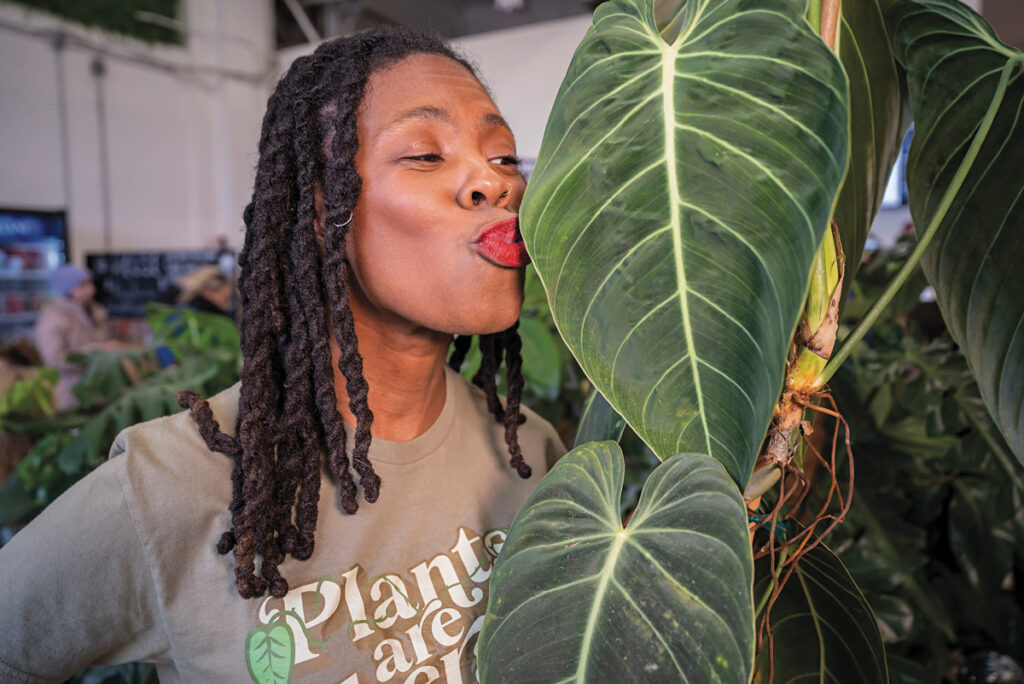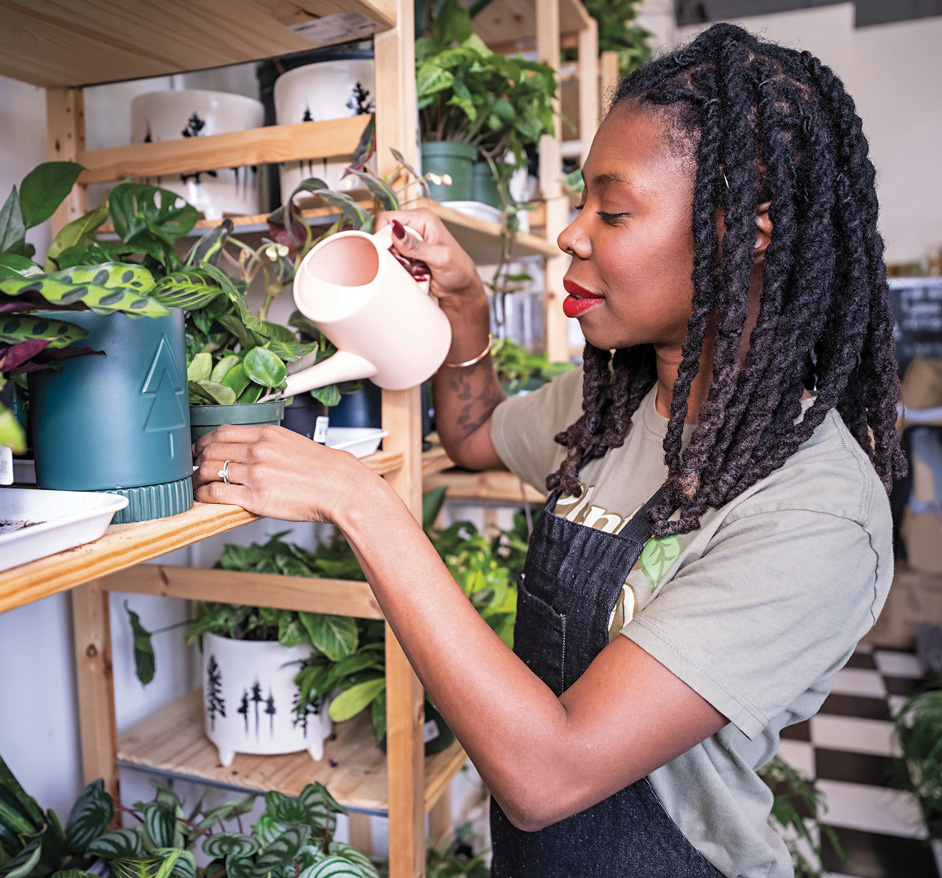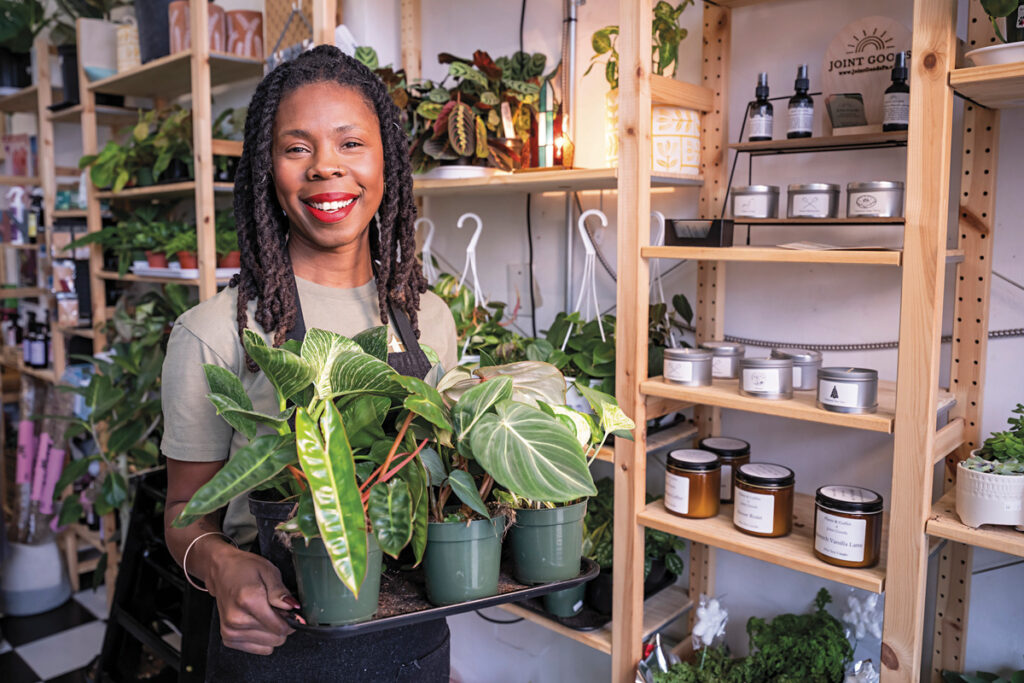
BY VERONICA HUNTER MOORE | PHOTOS BY OLAF STARORYPINSKI
AS I WALK THROUGH MY PLANT-FILLED HOME, I feel grateful for the gift of plants and all of their benefits. I’m surrounded by some favorites—such as hoya, snake plants, marble queen pothos, monstera “Thai Constellations,” and a host of philodendron varieties (brasil, squamiferum, atapobonese, silver sword and mayoi, to name just a few)—all soaking up the light into their leaves.
But their benefits extend beyond adding color and beauty to my life. I feel an ancestral connection, a thread that binds me to the leaves I touch and to the soil of a repotting session as the potting medium moves through my hands. When I’m outside prepping my vegetable beds, I’m looking for a connection to my mother and nature, but don’t need to do much at all to find it. The soil beneath my feet in Bethlehem calls out to my Southern ancestors, who have acted as stewards to this land many years ago.
This connection to the land extends much further than the mere act of growing plants or vegetables; it’s a profound bond, a tapestry woven from the stories of hard work, resilience, and the understanding that nature is our greatest teacher. But that journey has not always been easy—as no journey ever really is.
In the lush, fertile fields of my family’s first place of residence in Holly Springs, Mississippi, the legacy of tending the earth stretches back through generations, rooted in the resilient spirit of sharecroppers. My mother’s maternal lineage tended to the fields of cotton, vegetables, and fruit under no choice of their own. It was out of necessity and the need to survive.
My grandparents were among them, weathering the challenges of the land and the tumultuous times of unjust working conditions. More specifically, my grandfather nurtured and grew crops that sustained the family. His wisdom and love for the soil passed through my mother’s hands, where she cultivated not just what grew in the garden, but also a deep reverence for nature’s cycles. Our yard was a haven for nutritious fresh produce, right at our fingertips. Inside, our houseplants, which acted as live window treatments for our visual and respiratory benefit, flourished. They were a reassuring reminder of life and a constant example of tenacity.

While growing up in Markham, Illinois, I experienced through my mother all the cultivation that came before me, and those before her. She bestowed upon me the sacred knowledge of gardening and taking care of houseplants, ensuring that our family tradition would flourish into the present day. When I was my elementary school daughter’s age, our house plants included pothos, yucca plant, umbrella trees, snake plants, spider plants, dumbcane, and Chinese evergreen. My mother spent lots of time cultivating their growth, ensuring they had what they needed to thrive, no matter the space. She paid close attention to them during watering time, a practice that I was drawn to as a young child and still am to this day.
I learned, too, about growing food for sustenance. Among the abundant weekly garden harvest were tomatoes, cucumbers, bell peppers, jalapeño peppers, and banana peppers. And zucchini, yellow summer squash, and enough collard, mustard, and turnip greens to produce a big pot of smoky goodness to savor. I eagerly awaited when my mother would request that I go out early in the morning and pick the green tomatoes that she would fry to a crispy golden brown for our warm weather Saturday breakfast. (This was my favorite garden task.) My mother is no longer earthside, but I grow green tomatoes every summer and ask my daughter to pick them. My daughter learns not only about my mother, but her great-grandmother and grandfather, too, through all these planting practices.
Planting the Seeds of Personal Growth
My mother was a strong woman who was not easily shaken or broken. At a young age, I witnessed her experience great heartache and pain. From dealing with the loss of her closest siblings to the sudden and accidental death of her father (the man who taught her so much about gardening), I watched her overcome obstacle after obstacle and saw her pour her hurt, pain, grief, sorrow, and even joy into the land to which she sowed her seeds. I watched her through it all. Little did I know that later on in my life I would find myself reaching back to these memories to help me along my journey with plants and personal healing.
That journey started around 2019. During this time, I was working through grief therapy from the unexpected death of my sister (my biggest cheerleader) the previous year. It took me an entire year to find the courage to start traditional talk therapy. I was so afraid of what would arise in me emotionally. I wasn’t ready to feel that pain, so I poured myself into nurturing plants instead.
Caring for plants took me out of a dark place. It gave me a glimpse of hope when I was deep in despair. I felt like life wasn’t worth living. So when I share that plants saved my life, I mean it! But I wasn’t alone in my understanding and devotion to their abilities. They continued to provide me (and others, I’d soon learn) with another opportunity for healing, during Covid shutdowns. To cope with the fact that the world, as we knew it, was at a standstill, I purchased houseplants from local sellers and browsed Facebook groups that included people like me who loved houseplants. I was looking for a community that understood my connection to plants was deeply ingrained.

I couldn’t quite find the plant people I was looking for. So, in May 2020, I created a community on Instagram, Brown Skin Plant Mama, which focuses on sharing my plant-raising experience as a mental wellness and healing tool. In doing so, I brought awareness to how others could do the same. My first act of service involved donating over 300 houseplants to every student at my daughter’s school during the 2020–21 academic year. I accomplished this through the generous donations of The Curious Plantaholic plant shop and parent fundraising in grades K–8. The local media soon picked up on the work I was doing; others found out about me, too, including community organizations and my former colleagues at Lehigh University. I was asked to speak to local elementary and college students and community members about plant therapy. All of a sudden I was considered an expert….
Sharing the Power of Plants
I’m still sharing the transformative power of cultivating plants through my workshops throughout the community, in schools, and at corporate wellness events. The act of nurturing a seed into a thriving plant mirrors our own challenges and growth. It teaches us patience, resilience, and the beauty of life’s cyclical nature. The same is true when caring for houseplants that act as decorative ornaments—sure, but they’re also air purifiers, helping us to breathe more clearly. Plants are healers!
Plant therapy goes beyond the tangible yield of fresh produce. Each seed planted represents a story; a connection to our past and a hope for the future. Each unfurled leaf on a houseplant represents the growth that is happening that we can’t yet visually see, and then all of a sudden, boom, we can see it clear as day.
These ancestral teachings showed up when I least expected them—but most needed them. As I delve into the art of growing, I honor the lessons passed down, ensuring that the roots of our family history continue to grow and thrive. As a result, I will always grow the garden staples. We’ll of tomatoes, peppers, greens, and squash, while also adding a few others like arugula, romaine, watermelon, cantaloupe, and okra. The harvest will evolve, based on where I am and what I am doing. I can adapt, based on what we all need at any given time.
Some days it’s watermelon for my little ones, who devour fruit. Other days it’s fried green tomatoes to feed the Moore household’s fix, and to also ensure we aren’t fighting and fussing over the last piece! I also definitely plant for the culinary side of our lives with our barbecue restaurant, the Taste Smokers. We share our Southern food roots through our business. So, staples like collard greens—a crowd favorite and highly requested item—will show up more often on the menu. As my mother would say, “Ain’t nothing like greens picked from yo’ own garden!”
The act of nurturing a seed into a thriving plant mirrors our own challenges and our own growth. It teaches us patience, resilience, and the beauty of life’s cyclical nature.
As I reflect on the plant types of my childhood home, they all boasted characteristics of resilience that my mother also embodied. They connect me to the difficult past of my ancestors, who grew because they had to, not because they wanted to. What a burden it was to bear. However, subsequent generations have benefited from the learning, the growing, and the toiling of the earth that the ancestors endured. It has created a birthright journey, if you think a bit deeper. From generations of necessity to latter lineages of practice for enjoyment, reverence, and therapeutic activities, the beautiful art of gardening is an inheritance and gift here in the U.S. for people connected to the African diasporic movement. Those labors of love sustained us, but they also connected us to our communities and to the earth.
I have found myself. I continue to ground myself through planting and growing. Witnessing the joy as someone harvests their first vegetable or experiences the tranquility of tending to a garden is an indescribable reward. I invite you to join me in this experience. It just takes one plant, one seed. Let’s deepen the roots of our heritage and watch as those seeds bloom into a future where the wisdom of the land continues to nurture both our gardens and our souls. •




